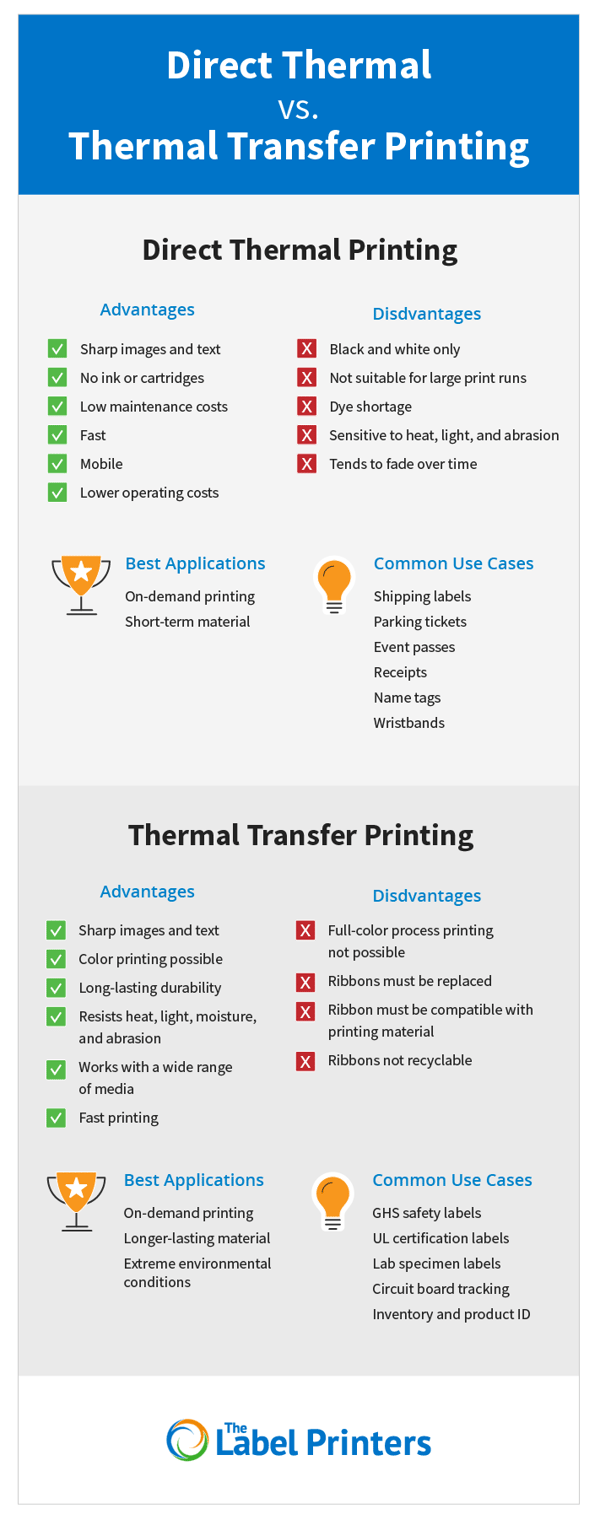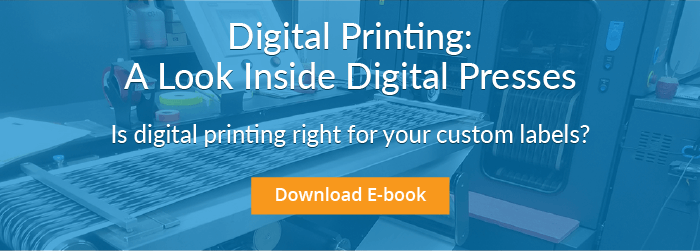
Ask your label printer for “thermal labels,” and you’ll probably get an immediate follow-up question: “Do you know which kind of thermal label you want? Do you need direct thermal or thermal transfer?”
If you don’t know the answer to your label printer’s question, that’s okay! An experienced label printer should be happy to explain the differences and make suggestions based on your needs.
If they don’t do that (or if their explanation wasn’t clear), read on.
There are, in fact, two different ways of using heat to apply images and words to material. The differences may be as clear as night and day to your label printer, but to a layperson, they’re perhaps a bit confusing.
In this article, we’ll dig into the direct thermal vs. thermal transfer debate, explaining the differences between the two types of thermal labels, some use cases, and the advantages and disadvantages of each technique.
What Are Thermal Labels?
Thermal labels can refer to labels printed via one of two processes that use heat to apply imagery or writing to specially-treated surfaces.
The two types of thermal printing are direct thermal printing and thermal transfer printing.
The following infographic presents a quick overview of the pros and cons of direct thermal vs. thermal transfer printing. Then, read on for more specific details.
What Is Direct Thermal Printing?
Direct thermal printers require special paper or printing material that has been coated in leuco dye. The interesting thing about leuco dye is it can switch between chemical forms, one of which has no color. A blank sheet covered in leuco dye appears to be just that, a blank sheet.
A direct thermal printer has a heating element in its printhead. When the heat makes contact with the printing material, the ink changes from colorless to dark, and writing or imagery appears. (Incidentally, sometimes it’s the printhead that moves. Sometimes it’s the printing surface — paper or film — that moves. It depends on the printer.)
Where Have I Seen It Before?
If you have an Amazon delivery box lying around (and who doesn’t these days?), scrape your fingernail or a pen cap across the label. If a dark line appears, you’re probably dealing with direct thermal printing.
Retail store receipt printers typically also use direct thermal printing.
Other Common Applications
Besides shipping labels, direct thermal printing is most often used in applications where longevity is not necessary. Think about a ski lift ticket, for example. The tickets need to be printed quickly for each customer but don’t usually have to endure longer than 24 hours.
Other uses for direct thermal printing include short-term items such as:
- Parking tickets
- Patient wristbands
- Event passes
- Name tags
- Receipts
What Are the Advantages of Direct Thermal Printing?
Direct thermal printing is frequently used for barcodes and other scannable material because it consistently turns out sharp, high-definition graphics and text. Other advantages of direct thermal printing include:
- Direct thermal printing doesn’t use ink or cartridges. The chemically treated printing material is the only consumable required.
- Minimal supplies also mean less maintenance and lower maintenance costs.
- Direct thermal printers are fast (another reason they’re often used for receipts or shipping labels).
- Direct thermal printers can be small and mobile.
- Direct thermal printers tend to cost less to operate vs. thermal transfer printers.
What Are the Disadvantages of Direct Thermal Printing?
Direct thermal printers can’t print in color. However, your label printer may be able to print “blanks” with your company logo and other colored elements. You can then run the blanks through a thermal printer.
Direct thermal printing is most cost-effective in small quantities. When you need large amounts of the same label — think, an entire roll or more — traditional printing methods may be more affordable.
Related content: Wondering how else to make cost-effective label choices? Read our blog, The Cost of Custom Labels: What Impacts Pricing?
Another complication to be aware of is that the world is currently experiencing a shortage of leuco dye. The Chinese government has cracked down on emissions from the plants that manufacture the dye, resulting in a production slowdown.
Other reasons to consider alternatives to direct thermal printing include:
- Excessive heat and light can darken the direct thermal printing surface, rendering text unreadable and barcodes unscannable.
- Direct thermal printed labels tend to fade over time.
- Abrasion can also darken the material. (Remember what happened when you scraped that Amazon shipping label?)
In general, in a direct thermal vs. thermal transfer printing matchup, direct thermal does well when speed, mobility, efficiency, and cost-effectiveness are the top priorities. When durability matters, thermal transfer printing may have the upper hand.
What Is Thermal Transfer Printing?
If you’re unsure about the difference between the two methods when it comes to direct thermal vs. thermal transfer printing, the trick to understanding is the word “transfer.” While direct thermal printing uses heat to transform ink that is already embedded in the printing surface, thermal transfer printing uses heat to “transfer” ink onto the paper.
Thermal transfer printers use a wide ribbon covered in a waxy substance. The heated printhead causes the wax to melt and bond with specially-treated paper or printing material. Typically, the ribbon is black, but thermal transfer printing ribbons are available in different colors.
Where Have I Seen It Before?
Thermal transfer printing is typically employed in scenarios where the printed material needs to survive a long time – or indefinitely – without fading or becoming unreadable. For example, GHS safety labels (the Globally Harmonized System of Classification and Labeling of Chemicals) are often printed on-site using thermal transfer printers.
Related content: Learn more about safety labels with our helpful Guide to Industrial and Automotive Labels.
Other common uses for thermal transfer printing include:
- UL certification labels
- Lab specimen labels
- Circuit board tracking
- Inventory and product identification
Thermal transfer printing is also a good choice for extreme environments, such as freezers or the outdoors.
What Are the Advantages of Thermal Transfer Printing?
Like direct thermal printing, thermal transfer printing is a speedy printing method known for creating high-definition, highly accurate text and imagery. Thermal transfer printing is also an excellent solution for printing barcodes.
But thermal transfer printing has the added benefit of color and increased durability. These two characteristics make it a good choice for low-volume and on-demand applications.
As opposed to direct thermal printing, thermal transfer printing:
- Produces long-lasting, archival-quality labels.
- Resists damage from moisture, heat, and light.
- Does not rub off easily.
- Can be applied to a huge range of printing media, including paper, polyester, and polypropylene.
Compared to other forms of on-demand printing, such as dot matrix or laser printing, direct thermal printing is typically more cost-effective, if not quite as affordable as direct thermal printing. Direct thermal transfer printers are durable, with long-lasting print heads and few long-term maintenance expenses.
What Are the Disadvantages of Thermal Transfer Printing?
While thermal transfer printing ribbons are available in colors other than black, the technology does not allow for full-process color printing. For example, if you want to print the color green, you have to find a green printer ribbon.
(GHS safety labels require only four colors, so thermal transfer printers used for that purpose come outfitted with all four.)
Thermal transfer printers also consume more material than direct thermal printers; the waxy ribbons must be replaced periodically.
There are a few other downsides to thermal transfer printing:
- Thermal transfer ribbon cannot usually be recycled.
- Your choice of ribbon must be compatible with your choice of printing surface. Otherwise, the hot printhead can melt the ribbon onto the label (which creates a mess and can damage the equipment).
How Your Custom Label Printer Can Help
A knowledgeable, experienced label printer will be able to help you weigh the pros and cons of direct thermal vs. thermal transfer printing and recommend the option that best suits your application and budget.
One common myth about thermal labels (printed via either method) is that you can only purchase your label materials from the company that manufactured your thermal printer. The truth is that a good label vendor will be able to customize labels to whatever size requirements you specify. That includes the width of the label, the width of the liner, and the spacing between the labels on the liner.
If you need to print labels at a higher volume than is practical with thermal printing, or if the look of your labels is stable and you want to stock up, your label printer can help there, too. Thermal labels are just one of many modern label printing options available. An experienced label printer can help you choose the printing technology that matches your needs and budget.
Ready to talk about your label printing needs? Contact us today.


